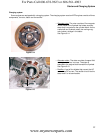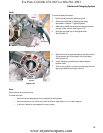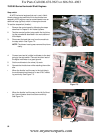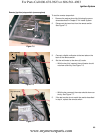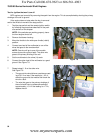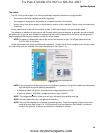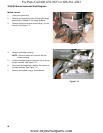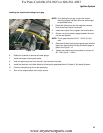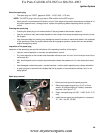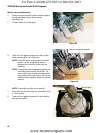
Ignition System
85
The module
The coil in this ignition system is an inductive discharge magneto, contained in a single module.
• The inductive discharge magneto has a two leg design.
• The magneto is energized by the passing of a magnet mounted in the flywheel.
• Ignition timing is set by the location of the flywheel in relation to the crankshaft. Proper timing is maintained by
a steel key.
Normal performance of the coil is to produce at least 10,000 volts at starter-rope pull-through speed.
The presence or absence of strong spark, with the stop switch known to be good, is generally enough to identify
the ignition coil as good or bad. Resistance readings may help confirm the source of the failure, but are generally
meaningless because they only measure a small part of the module.
NOTE: No spark or a weak spark may be the result of an improper air gap. The air gap space should be
0.016”-0.024” (0.4-0.6mm).
Simple spark-testers are readily available and inexpensive. Thexton Part # 404 is available from a variety of retail-
ers, and similar tools are available from other manufacturers. See Figure 7.10.
NOTE: If the complaint is that the engine quits running when it gets warm, the ignition module should be tested
with the engine at normal operating temperature.
• At operating speed, the ignition should produce voltage approaching 12,000.
• At pull-over speed (~
600 RPM), voltage should be at least 10,000V.
NOTE: The voltage required for a flash-over will vary with spark plug condition and gap.
NOTE: Pull-over speed may vary from operator to operator.
NOTE: Failure of the magnets in the flywheel is exceedingly rare. To test the magnets, simply hold an item
made of ferrous metal roughly 1/4” (0.635cm) away from the magnets in the flywheel. It should be
drawn to the flywheel. A wrench or screwdriver is suitable for this test.
Figure 7.10
Instructions on
back of package
For Parts Call 606-678-9623 or 606-561-4983
www.mymowerparts.com



